Following the summer rally, the market has been on a gradual decline in recent weeks. Gains are showing signs of rapid unwinding after Fed Chair Jerome Powell reiterated policymakers’ support for “higher for longer” rates to tame inflation. The pace of price increases have remained stubbornly above the 2% target range despite the recent trend lower. And there are still a myriad of factors – particularly the resilient labour market – out there that remain an active threat to keeping inflation in check.
The latest Fed dot plot shows support for the Fed Funds rate to hit the 5.50% to 5.75% range by year-end, implying another 25 bps increase at either the upcoming November or December policy meeting. Rate cut expectations for 2024 have also tempered, with policymakers’ latest projection implying a benchmark rate at 5.1% by the end of next year, which is about 50 bps higher than the 4.6% last projected in June.
Bloomberg News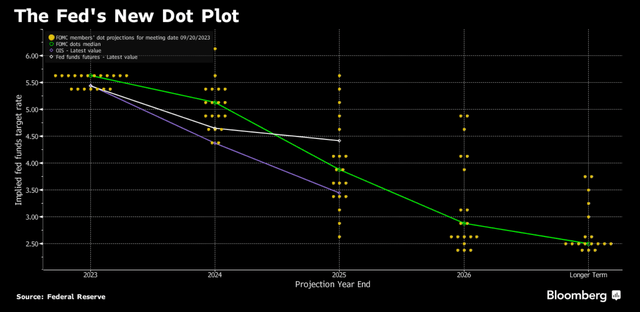
Meanwhile, the economy has withstood the most aggressive cycle of rate hikes in decades better than expected – both consumer spending and the labour market have been resilient, incentivizing an upward revision to the 2023 economic growth projection from 1% in June to 2.1%, with the expected unemployment rate tweaked lower from 4.5% to 4.1%. Although data suggests a soft-landing is possible, Chair Powell has denied such a scenario as the “baseline” and reiterated the Fed’s stance to keep monetary policy in restrictive territory for longer.
The remarks have taken the long-end Treasury yield above a 16-year high in recent weeks, while equity performance has also been losing ground. Although bonds have been pricing in the new normal of restrictive monetary policy for a while now, equity valuations appear to only now be catching up. We see several risks that are rapidly brewing into reality, which could suggest a sustained downtrend in the S&P (SP500/NYSEARCA:SPY) and Nasdaq (NDX/QQQ) valuations from current levels.
2% Inflation Target At Risk of Derailment
Inflation has shown signs of softening over the summer, but risks of a reacceleration are still running high. This is corroborated by August figures that came in stronger than expected, with both core and headline inflation running hot on the resurgence of energy costs and stubbornly high shelter costs.
Specifically, oil prices have “climbed nearly $25 from their summer lows”, representing 30% gains over the past quarter and trading comfortably above the $90 range. While oil prices have largely been driven by weak sentiment during the first half of the year, primarily influenced by fears of weakening demand due to China’s deteriorating economy which have overshadowed OPEC+ supply curbs, the reality of tightening supplies is settling in. And this is reflected in the recent surge in gasoline prices, which contributed to more than half of August’s monthly price increase. Meanwhile, the outlook on food prices also remains mixed, as the combination of rising energy and labour costs alongside shortages in American cattle and various crops due to extreme weather remain headwinds. Taken together, both core and non-core prices continue to face prominent risks of resurgence, underscoring August’s figures may be a warning sign.
With inflation still running hot, the higher for longer narrative is likely to settle in as the new normal. We fear that this set-up may be ushering in the most adverse implication possible – the Fed may stop pursuing a goldilocks soft-landing scenario and opt for a forced correction of the economy, as the situation becomes increasingly politically-driven. And Chair Powell’s recent rejection of the economic soft landing as a baseline scenario is corroborative of this risk. The higher for longer rate environment has pushed Treasury yields toward an all-time high. 10-year Treasury yields have rapidly surged beyond the 4.6% range, while the five-year is approaching 4.7%. Meanwhile, the rate-sensitive two-year yield has experienced a relatively gradual uptrend, reaching about 5.1%.
At these levels, the government faces acute financial pressure to funding operations. For context, nearly a third of total U.S. government debt outstanding is set to hit maturity within the next 12 months, with more than a half set to mature over the next three years.
U.S. Treasury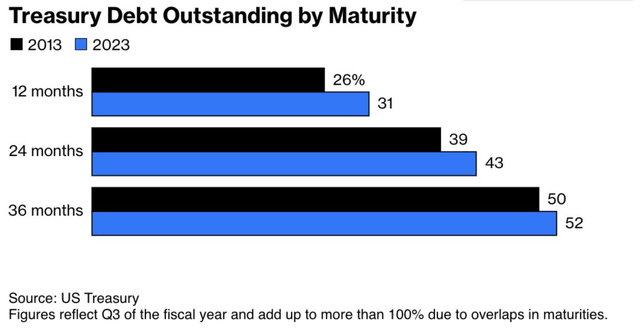
This underscores the massive refinancing needed over the foreseeable future, and more importantly, the government’s exposure to impact from an adverse rate environment. The cost on related debt has already surged from 1.5% from when it was last financed, to now 3.0%. And the doubling rate is poised to climb further in tandem with rising interest rates, underscoring quarterly interest expense payments beyond the current all-time high of $1 trillion in no time.
The ever-increasing federal debt burden, coupled with rising debt service costs implies the potential for tax increases, which could adversely impact the economy further as still-hot inflation and tightening financial conditions run simultaneously in the background. More importantly, the combination will be adverse to the Biden administration’s outlook on extending its term heading into the 2024 re-election. To prevent this unfavourable mix, Chair Powell and Co. may need to tighten credit conditions further to manually orchestrate the slowdown needed to put the economy into correction, putting conditions for a soft landing further out of reach.
Adding pressure to this dire set-up is the mechanics of leveraged rate funds that have been increasing their short wagers on Treasury leading up to the September FOMC meeting. The net-short positions on Treasuries futures held by leveraged funds reached their highest levels in more than a decade in August, incentivized by persistent economic challenges spanning “inflation, tight labour market and the hawkish Fed”. The net carry on cash Treasury and futures prices may have also incentivized the build-up of bearish bets. However, the recent surge in yields could potentially lead to an unwind of this net-short positioning, and pressure bonds’ performance further by creating shock waves that will ripple throughout the market. The unpredictably elevated nature of long-end Treasury yields is corroborated by the normalization of the five- and 30-year Treasury yield curve last week – a year after the curve’s inversion reached its highest in more than a decade.
…a large but orderly unwinding of hedge funds’ positions in Treasuries could push yields higher relative to other fixed-income instruments…
Source: Reuters
Lofty Equity Valuation Premiums
In addition to persistent inflation and tightening financial conditions, the overvalued nature of equity valuations at current levels is what greenlights the impending risk of a broader market crash. Prior to the onset of the late September market slump, the S&P 500 had been trading at a record high of almost 30x forward earnings, representing a rich valuation premium to 10-year average of about 23x. Much of this uptrend had been buoyed by the market’s frenzy for AI, with the Magnificent Seven stocks – namely, Apple (AAPL), Amazon (AMZN), Google (GOOG / GOOGL), Meta Platforms (META), Microsoft (MSFT), Nvidia (NVDA) and Tesla (TSLA) – trading at an average forward P/E of more than 40x and accounting for about a third of the S&P 500 index’s performance. But the S&P 500, ex-Magnificent Seven, is not cheap either – it currently trades at about 24x estimated earnings, and still exceeds the 10-year average of about 21x on the normalized gauge. The resurgence of tech valuations is corroborated by the Nasdaq 100’s lofty premium built-up this year – the tech-heavy index is currently trading at more than 30x estimated earnings, far exceeding its historical average of about 23x.
Bloomberg News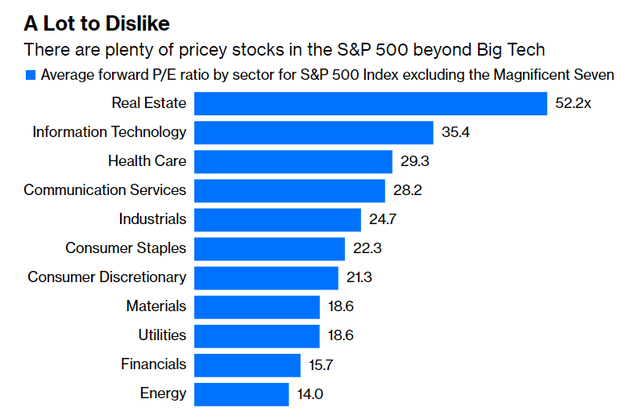
Although long-end Treasury yields have long been pushing new highs since the onset of the latest rate hike cycle, which have been adverse to growth valuations underpinned by cash flows further out in the future, the market’s rally this year has largely defied these challenges most prominently observed during 2022. Markets had likely been pricing in expectations for an eventual normalization in the rate environment during the first half of the year, as improving inflationary pressures harbinger the impending unwinding of monetary policy tightening. This is supported by observations of historically low equity risk premium priced into market valuations.
Recall that the ERP measures the difference between returns on equities versus the risk-free rate of return on Treasury. The yield on short-end Treasury bills had consistently exceeded the average return on equity as measured by the inverse of the S&P 500 P/E ratio during the first half of the year – a first since 2000 – likely on the back of expectations for increased visibility on an eventual trajectory back towards monetary policy easing. Even with the recent slump in stock valuations, the close to 5.5% yield on three-month T-bills still exceeds the average 4.2% return on equities computed on the inverse of S&P 500 ex-Magnificent Seven P/E ratio of about 24x, despite the latter’s higher risk exposure.
This suggests that the market’s latest declines following the Fed’s reaffirmation on a higher for longer rate reality is a reflection of swift adjustments to the ERP. While valuations have not budged in the face of continued rate hikes during the first half of 2023, they might very well start to as the potential of a soft landing and eventual policy easing are pushed back until further notice. Recall the CAPM model, which dictates the cost of equity based on both the stock and broader market’s risk profile. The cost of equity is computed as the risk-free rate plus the equity beta multiplied by the ERP.
CAPM Model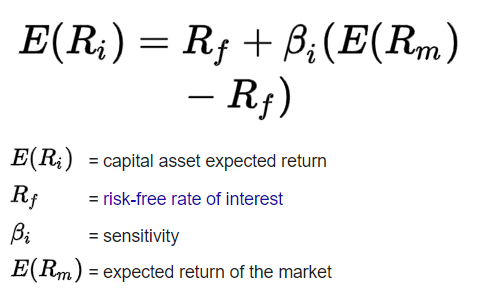
The cost of equity is typically more sensitive to changes in the ERP than the risk-free rate itself. As markets are likely to upwardly adjust the ERP in response to the new normal of higher for longer interest rates, the discount factor on future cash flows accordingly increases, risking a further decline in equity valuations from current levels.
Currently lofty market valuations also face brewing weakness among financial names. While market sentiment has normalized since the slew of regional bank failures in March, it does not materially change the reality that an elevated rate environment does not bode well for the financial sector. Higher rates essentially mean higher borrowing costs, and narrowing net interest margins for the banks. Customers will continue to be incentivized to rotate their deposits into higher-yielding products and accounts, impacting the availability of low-cost funding for banks to service its lending operations and, inadvertently, pressuring net interest income. Meanwhile, borrowing will likely remain weak in the face of an elevated rate environment as home buyers and investors stay risk averse, which will hamper banks’ earnings further.
While both regulators and banks have bolstered capital buffer requirements to better “cope with a severe economic shock”, especially following the slew of bank failures earlier this year, the sector’s exposure to weakness persists amid the elevated rate environment. As Treasury yields continue to rise, the value of long-term notes held by banks diminishes. While much of these losses stay unreported on P&L, as banks stash the holdings away as “available for sale securities” with their unrealized gains / losses flowing through AOCI, the diminishing value of bond assets affects banks’ level of equity on the balance sheet. The average capital requirement – or CET1 ratio – for large banks currently average 8.95%, which implies that for every $10 the bank lends, it must have at least $0.895 of capital in reserve. This also indicates that banks typically operate at about 10x leverage, which exposes them to risks of a significant equity value correction in the event of material depreciation to asset value – a case proven in the failures of Silvergate Bank, Silicon Valley Bank, Signature Bank, and First Republic Bank.
Taken together, the window of weakness on equities is rapidly expanding at current levels. The durability of current valuation premiums are becoming increasingly at risk, given weakness in underlying fundamentals amid the elevated rate environment.
Other Risk Considerations
In addition to persistent inflation, higher for longer interest rates, and lofty equity valuations, there is also a broadening portfolio of other moving pieces indicative of further market weakness to come:
Government shutdown: The U.S. government has narrowly dodged a shutdown this weekend with the agreement on a 45-day extension for ongoing negotiations regarding long-term funding. But this does not eradicate the impending risk of a potential no-deal, which could bring on adverse implications for equity valuations.
The market has historically rallied upon the end of a government shutdown/averted shutdown. This was also the case earlier this year, when the government had averted a shutdown (and potential financial crisis) after an agreement to suspend the U.S. debt ceiling. However, the increasing frequency of government shutdown risks (two times this year) amidst an inflationary environment and tightening financial conditions is unprecedented. This is in line with the market’s modest response to the latest risk of a government shutdown – much of the recent market downside realized were likely attributable to the reality of a higher interest rate environment settling in, which means that the averted shutdown is unlikely to be a “big source of upside” in the near-term.
Bloomberg News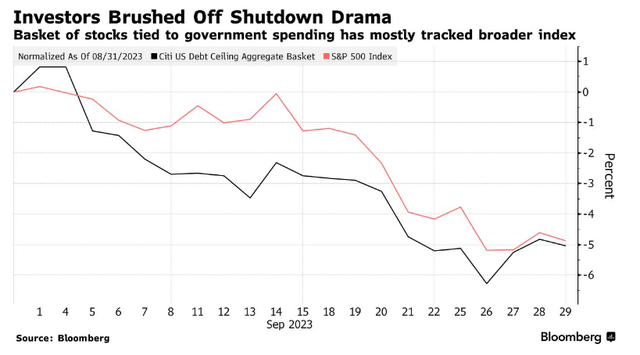
But the mire of political drama is likely to further dampen confidence in the U.S. government’s ability to navigate the economy back to health. Current models estimate a 0.2 percentage point headwind to annualized GDP growth for each week of government shutdown that could potentially take place in the fourth quarter if the 45-day impasse ends with no-deal. A further extension could also “impede the Fed’s efforts to quell inflation”, risking a reversal of recent progress made.
De-risking VIX: The VIX, which measures stock market volatility expectations, also remains dampened at sub-20 levels considering the current market risk profile. Under the Rule of 16, which divides the current VIX by 16 to gauge the implied stock market movement, current options pricing suggests a ~1% daily movement in the S&P 500. We do not think this has sufficiently de-risked for impending market risks.
Instead, the modest VIX is likely underpriced for the current market risk profile set-up due to the supply and demand mechanics in options markets, influenced primarily by structured product funds. Specifically, options selling for passive income at some of these funds may be weighing on the VIX, resulting in the gauge’s inadequate reflection of pent-up stock market volatility, which risks becoming an overlooked factor.
Another implied risk to consider is the historical link between month-end options expiry (“mopex”) that happens on the third Friday of each month, and an equity market collapse. The onset of the equity market collapse observed in February 2020 had coincided with mopex on February 21. This eerily resembles the latest stock slump, which began the third Friday of September, in line with the latest mopex.
Weakening consumer spending backdrop: The narrative on weakening consumption amid inflationary pressures and an elevated borrowing cost environment has been brewing for more than a year. Yet corporate earnings have largely stayed resilient, leading markets to contemplate if relevant risks have already been priced into current market valuations.
The resilient labour market amid the latest cycle of monetary policy tightening has been a primary counteractive force to the adverse combination of dwindling pandemic-era savings and persistent inflation. But this last lever is likely going to give soon. Credit card delinquencies are surging above pre-pandemic levels, while the resumption of student loan repayments this month is likely to weigh on household budgets further. Specifically, cutting out room in budgets for student loan repayments is expected to displace $100 billion in annual discretionary spending and impact GDP growth by 0.1% this year and 0.3% next year.
Bloomberg News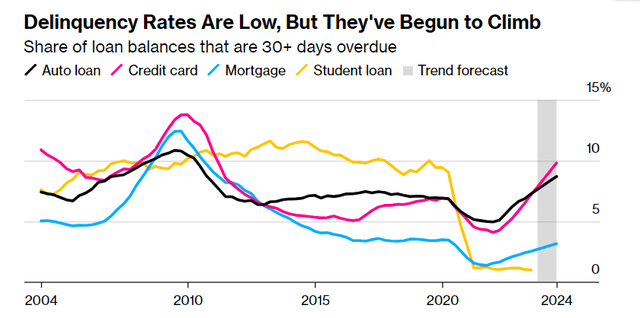
Unfortunately, the added burden on consumer budgets also coincides with the timeline of which the lagging monetary policy effect on labour markets is due to materialize. Different parts of the economy have different sensitivities to monetary policy tightening. And for the labour markets, which has been resilient through it all so far, typically starts to feel the impact of monetary tightening at the 18- to 24-month mark. That means the “full force” of the 0% to 5.5% rate hikes implemented since March 2022 are about to be felt by the labour market from here on out, potentially eradicating a key source of strength that has been keeping the economy afloat so far. With at least one more rate hike in the books, the impact of weakening consumer spending might finally be starting to hit the underlying fundamentals critical to supporting the market’s lofty valuation premiums at current levels.
The Bottom Line
While 2023 has largely defied the market’s pessimism and turned out to be a good year for equities so far, vulnerabilities to a violent downturn remain close. The combination of Fed hawkishness, political motives, weakening economic fundamentals and a potential earnings recession could risk sending new shock waves to the broader markets, putting the case for a soft landing further out of reach. The set-up is becoming increasingly unfavourable to the durability of equity valuation premiums at current levels, driving up risks that the latest uptrend might be finally running out of steam.
Read the full article here













